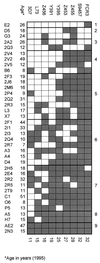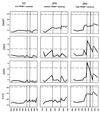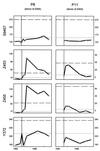Nine-year longitudinal study of antibodies to variant antigens on the surface of Plasmodium falciparum-infected erythrocytes
- PMID: 10417178
- PMCID: PMC96708
- DOI: 10.1128/IAI.67.8.4092-4098.1999
Nine-year longitudinal study of antibodies to variant antigens on the surface of Plasmodium falciparum-infected erythrocytes
Abstract
PfEMP1 is an antigenically variable molecule which mediates the adhesion of parasitized erythrocytes to a variety of cell types and which is believed to constitute an important target for naturally acquired protective immune responses in malaria. For 9 years we have monitored individuals living in an area of low-intensity, seasonal, and unstable malaria transmission in eastern Sudan, and we have used this database to study the acquisition, specificity, and duration of the antibody response to variant parasitized erythrocyte surface antigens. Both the levels and the spectrum of reactivity of these antibodies varied considerably among individuals, ranging from low levels of antibodies recognizing only few parasitized erythrocyte surface antigens to high levels of broad-specificity antibodies. In general, episodes of clinical malaria were associated with increases in the levels of parasitized erythrocyte surface-specific antibodies that subsided within months of the attack. This response was often, but not always, specific for the antigenic variants expressed by the parasite isolate causing disease. Our study provides evidence that Palciparum falciparum malaria is associated with a short-lived, variant-specific antibody response to PfEMP1-like antigens exposed on the surface of parasitized erythrocytes. Furthermore, our data suggest that the antigenic repertoires of variant antigens expressed by different parasite isolates show considerable overlapping, at least under Sahelian conditions of low-intensity, seasonal, and unstable malaria transmission. Finally, we demonstrate the existence of persistent differences among individuals in the capacity to mount antibody responses to variant surface antigens.
Figures



Similar articles
-
Overlapping antigenic repertoires of variant antigens expressed on the surface of erythrocytes infected by Plasmodium falciparum.Parasitology. 1999 Jul;119 ( Pt 1):7-17. doi: 10.1017/s0031182099004485. Parasitology. 1999. PMID: 10446700
-
Antibodies to variable Plasmodium falciparum-infected erythrocyte surface antigens are associated with protection from novel malaria infections.Immunol Lett. 2000 Feb 1;71(2):117-26. doi: 10.1016/s0165-2478(99)00173-x. Immunol Lett. 2000. PMID: 10714439
-
Antigenic cartography of immune responses to Plasmodium falciparum erythrocyte membrane protein 1 (PfEMP1).PLoS Pathog. 2019 Jul 1;15(7):e1007870. doi: 10.1371/journal.ppat.1007870. eCollection 2019 Jul. PLoS Pathog. 2019. PMID: 31260501 Free PMC article.
-
The role of antibodies to Plasmodium falciparum-infected-erythrocyte surface antigens in naturally acquired immunity to malaria.Trends Microbiol. 2002 Feb;10(2):55-8. doi: 10.1016/s0966-842x(01)02278-8. Trends Microbiol. 2002. PMID: 11827798 Review.
-
PfEMP1 - A Parasite Protein Family of Key Importance in Plasmodium falciparum Malaria Immunity and Pathogenesis.Adv Parasitol. 2015 Apr;88:51-84. doi: 10.1016/bs.apar.2015.02.004. Epub 2015 Mar 23. Adv Parasitol. 2015. PMID: 25911365 Review.
Cited by
-
Mannose-binding lectin is a disease modifier in clinical malaria and may function as opsonin for Plasmodium falciparum-infected erythrocytes.Infect Immun. 2003 Sep;71(9):5245-53. doi: 10.1128/IAI.71.9.5245-5253.2003. Infect Immun. 2003. PMID: 12933871 Free PMC article.
-
B-cell responses to pregnancy-restricted and -unrestricted Plasmodium falciparum erythrocyte membrane protein 1 antigens in Ghanaian women naturally exposed to malaria parasites.Infect Immun. 2014 May;82(5):1860-71. doi: 10.1128/IAI.01514-13. Epub 2014 Feb 24. Infect Immun. 2014. PMID: 24566620 Free PMC article.
-
Immunoglobulin G isotype responses to variant surface antigens of Plasmodium falciparum in healthy Gabonese adults and children during and after successive malaria attacks.Infect Immun. 2004 Jan;72(1):284-94. doi: 10.1128/IAI.72.1.284-294.2004. Infect Immun. 2004. PMID: 14688107 Free PMC article.
-
Age-dependent increase in antibodies that inhibit Plasmodium falciparum adhesion to a subset of endothelial receptors.Malar J. 2019 Apr 11;18(1):128. doi: 10.1186/s12936-019-2764-4. Malar J. 2019. PMID: 30971252 Free PMC article.
-
In Vitro Variant Surface Antigen Expression in Plasmodium falciparum Parasites from a Semi-Immune Individual Is Not Correlated with Var Gene Transcription.PLoS One. 2016 Dec 1;11(12):e0166135. doi: 10.1371/journal.pone.0166135. eCollection 2016. PLoS One. 2016. PMID: 27907004 Free PMC article.
References
-
- Baruch D I, Ma X C, Singh H B, Bi X H, Pasloske B L, Howard R J. Identification of a region of PfEMP1 that mediates adherence of Plasmodium falciparum infected erythrocytes to CD36: conserved function with variant sequence. Blood. 1997;90:3766–3775. - PubMed
-
- Baruch D I, Pasloske B L, Singh H B, Bi X, Ma X C, Feldman M, Taraschi T F, Howard R J. Cloning the P. falciparum gene encoding PfEMP1, a malarial variant antigen and adherence receptor on the surface of parasitized human erythrocytes. Cell. 1995;82:77–87. - PubMed
-
- Carlson J, Helmby H, Hill A V, Brewster D, Greenwood B M, Wahlgren M. Human cerebral malaria: association with erythrocyte rosetting and lack of anti-rosetting antibodies. Lancet. 1990;336:1457–1460. - PubMed
Publication types
MeSH terms
Substances
LinkOut - more resources
Full Text Sources

